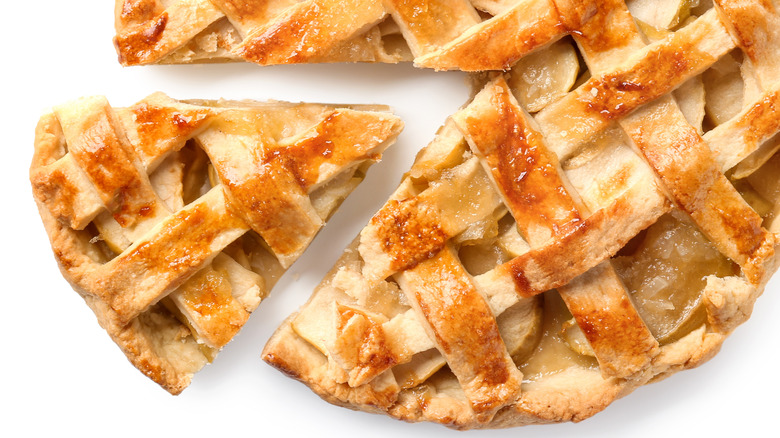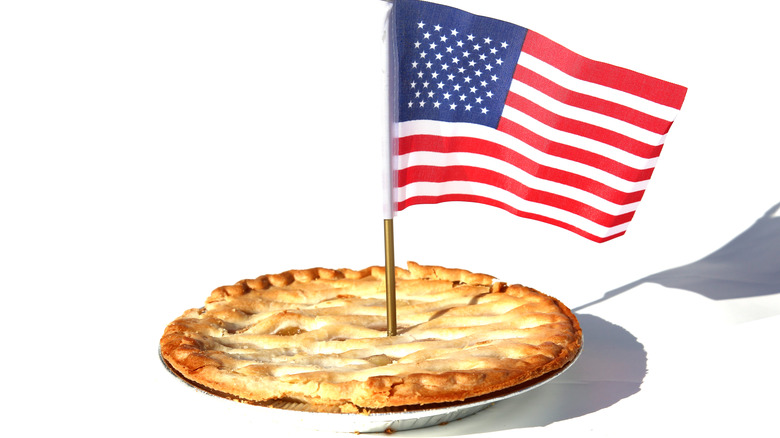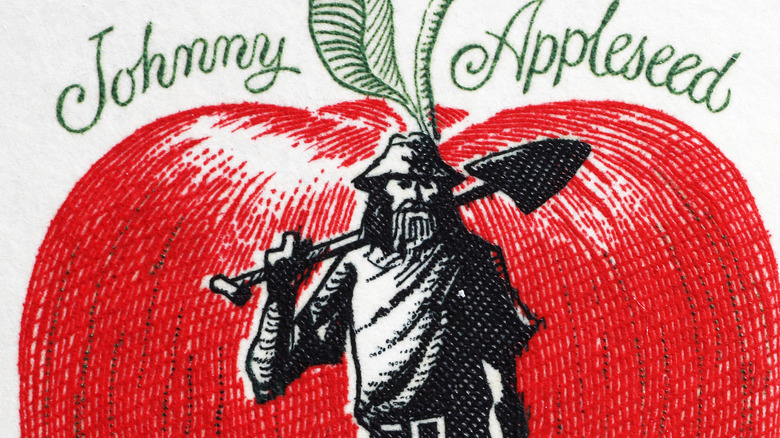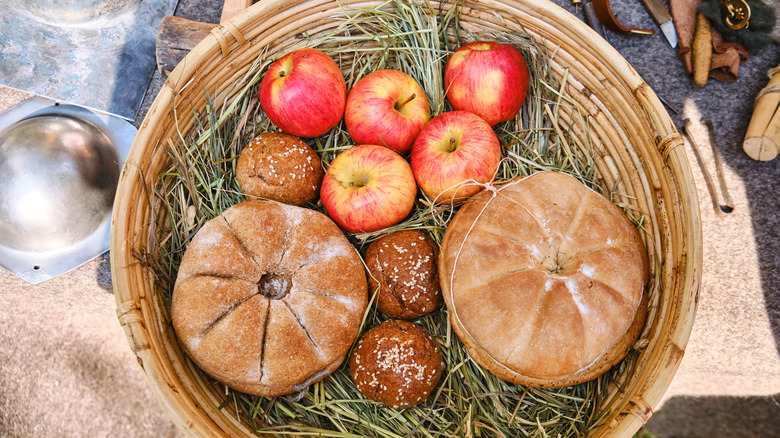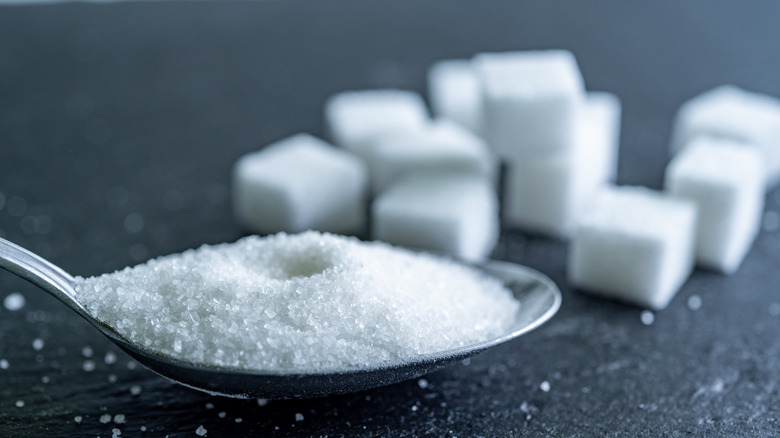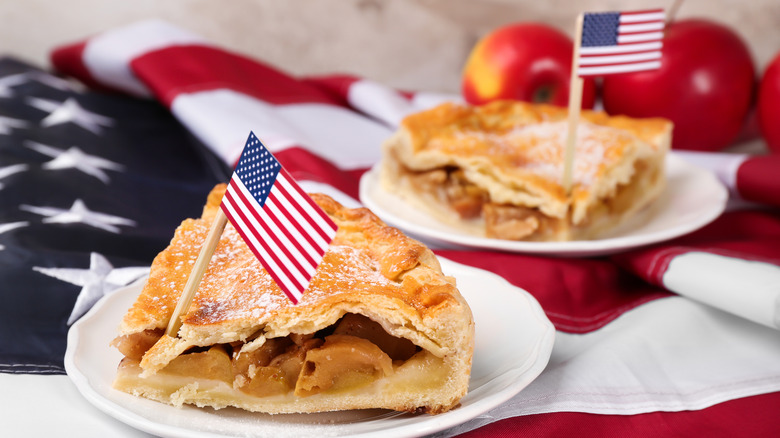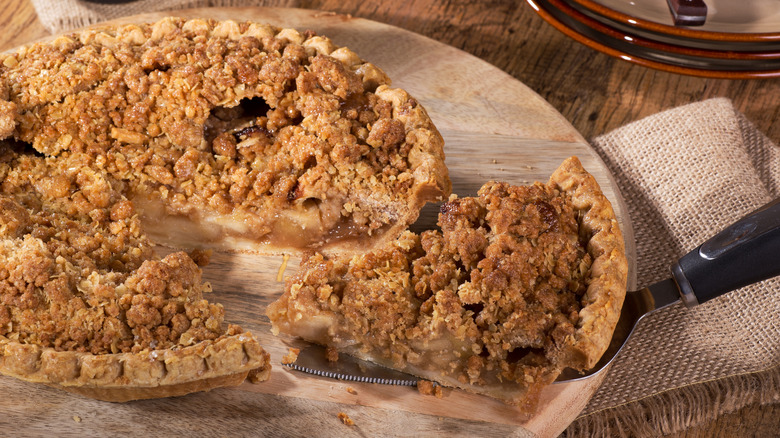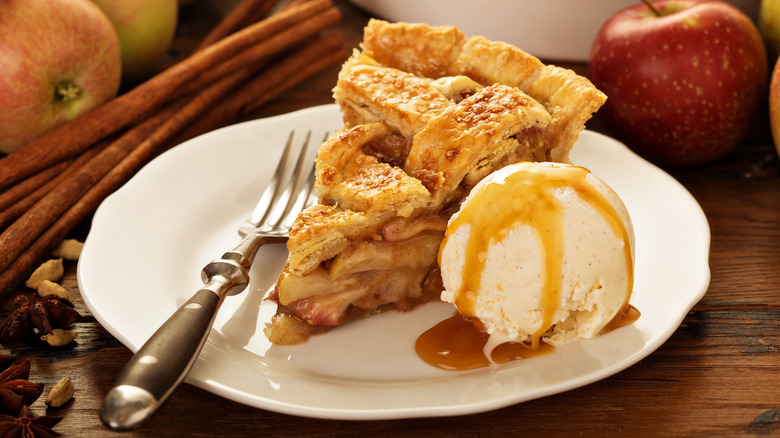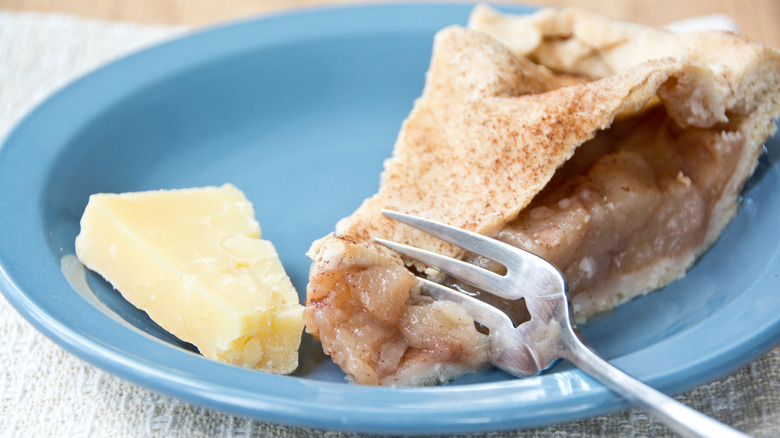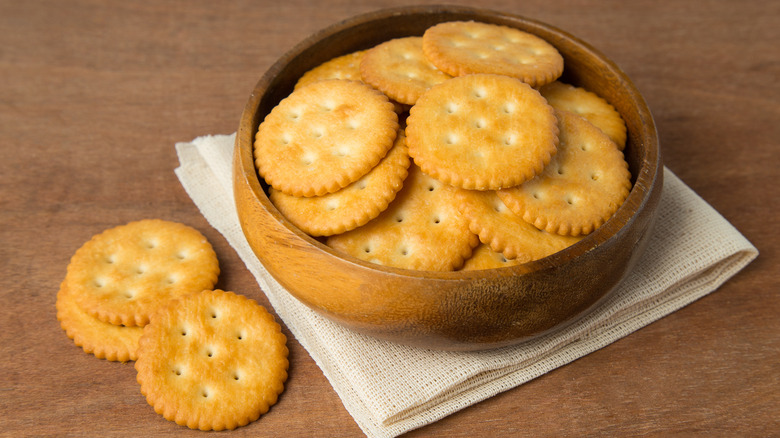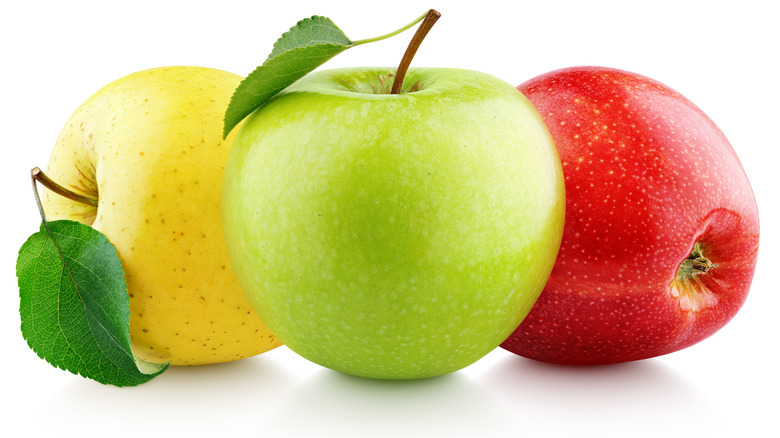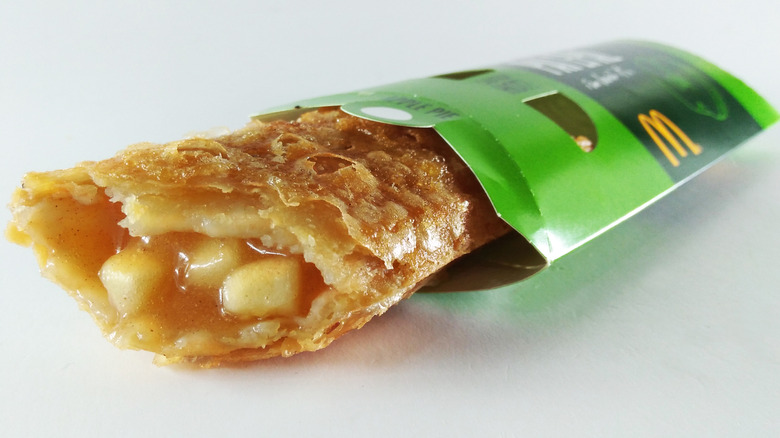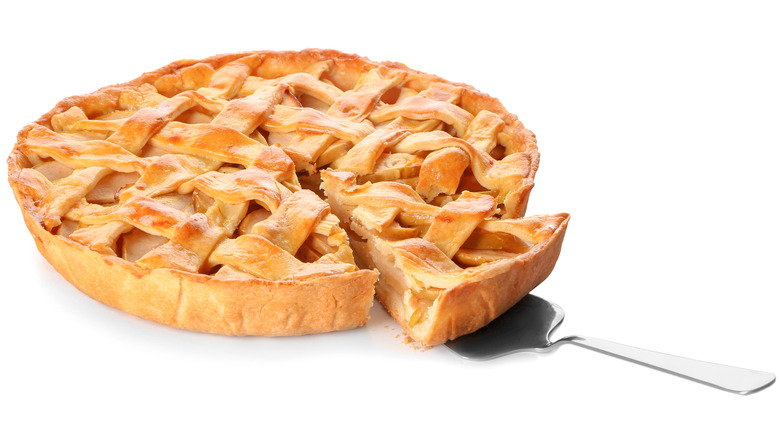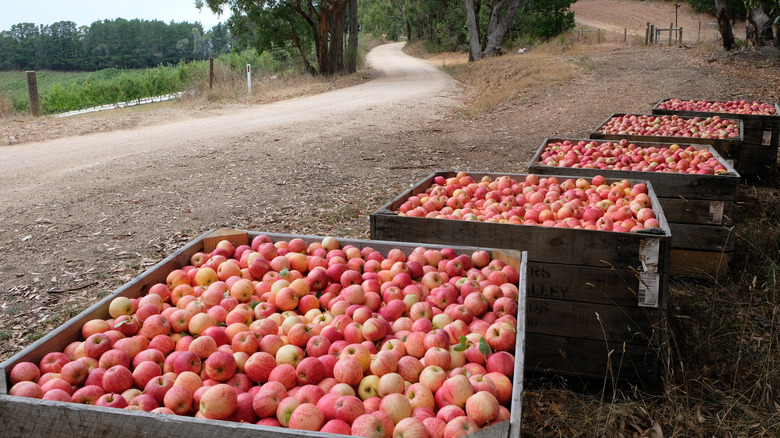The Untold Truth Of Apple Pie
Americana par excellence, apple pie is a stalwart favorite among diners across the country. According to a 2012 NPR survey, 17% of Americans like apple pie more than any other pie. While it's perhaps a narrow victory, it's a victory nonetheless, eking out the next-most popular pie fillings of strawberry rhubarb, pumpkin, cherry, and blueberry.
It's perhaps no surprise that apple came out on top. After all, there's supposedly nothing more American than apple pie. That delicious combination of cinnamon-spiced apples and flaky pastry can't be beaten, but there's more to apple pie than you might think.
From its convoluted history to its presence on fast-food menus, there have also been crazed debates over the best apples to use for pie recipes, as well as iterations made without any apples at all. Here's everything you might not already know about the beloved pie, as well as how it became synonymous with America.
Apple pie isn't as all-American as you'd think
Apple pie may seem like an all-American treat that is welcome everywhere from barbecues to the Thanksgiving table. According to Food52, however, rumors of apple pie as the all-American treat are highly exaggerated — bordering on completely fabricated.
First off, the very filling begs some eyebrow raises. The only apples native to North America are crab apples, which are far too sour for this delicious sweet treat. Apples, which originally hail from Asia, arrived by way of European settlers in the 17th century, according to Many Eats. The common apple pie seasonings of cinnamon and nutmeg, meanwhile, come from Indonesia and Sri Lanka.
Apple pie has been part of the American story for generations, with not 1 but 2 recipes for the dessert featured in the country's first cookbook, "American Cookery," published in 1796. However, its roots – and, indeed, the recipe – hail from elsewhere.
"When you say that something is 'as American as apple pie,' what you're really saying is that the item came to this country from elsewhere and was transformed into a distinctly American experience," John Lehndorff of the American Pie Council told Food52.
Johnny Appleseed was a real guy
Americans love their folklore, and while some of these stories are just stories, there's some truth to the legend of Johnny Appleseed.
Johnny Appleseed was the moniker given to one "eccentric frontiersman" named John Chapman, according to Many Eats. Chapman, according to Ohio History Central, was born in Massachusetts in 1774. At age 13, he was apprenticed to an orchardist who managed apple trees. At 18, he began roaming west, at first with his half-brother Nathaniel and then on his own, planting apple trees as a symbol of his Christian faith. By the end of his life, he claimed to have walked over 4,000 miles, spreading knowledge — and apples — wherever he went.
While there's no indication that Johnny Appleseed ever enjoyed the fruit baked into a pie, he was a key driver in encouraging the fruit's popularity in the U.S., thus paving the way for the apple to become the nation's favorite fruit baked into a pie.
The first apple pies date to medieval Europe
Not only do apple pie's ingredients hail from outside of the U.S., but the recipe also came from elsewhere. The first apple pies predate the country by quite a few centuries, originating in medieval Europe — specifically, England.
According to Food52, one of the first apple pie recipes ever can be credited to 14th century England, where it was published in a book called, "The Forme of Cury," by Samuel Pegge. This cookbook, according to What's Cooking America?, was compiled in 1390 A.D. by the master cooks of King Richard II.
While this pie is certainly an ancestor of the one we know and love today, it would be nearly unrecognizable to modern cooks. This is due, first and foremost, to the fact that the lovely, flaky crust we all seek was actually not meant to be edible. Then known as a "coffin," the apple pie's pastry base was envisioned as a container for the filling and not part of the dish itself, according to What's Cooking America?
The first apple pies were devoid of sugar
An inedible pastry base is not the only thing that made the first medieval apple pies stand out from modern iterations. Indeed, these recipes are also notable for their lack of 1 essential ingredient: sugar. Sugar in the Middle Ages, according to the Medievalist, was a rarity reserved for the wealthy. Sugarcane came to Europe from Asia by way of the Arab world, but since the plant did not thrive in European climates, it remained a rarity in day-to-day cooking.
The proof is in the pudding — or, rather, the pie. The original apple pie, as detailed in Samuel Pegge's "The Forme of Cury," was sweetened, not with sugar, but with figs, raisins, and pears. Spiced with saffron, it was notably devoid of both sugar and cinnamon.
It wasn't until 16th century England, according to What's Cooking America?, that apple pies featured edible pastry "coffins," cinnamon, ginger... and sugar.
The expression American as apple pie likely comes from the early 20th century
The first apple pies hailed from England, and the dessert became popular in France and Holland long before it became an all-American classic (via Many Eats). With that in mind, where does the oft-cited expression, "American as apple pie," come from?
According to Food52, apple pie first began to be associated with America in the early 20th century, when the New York Times claimed the pie had become "the American synonym for prosperity." The association only grew during World War I, when the Boston Daily Globe wrote that a soldier's craving for pie while stationed elsewhere was akin to a "hunger for democracy" (via Many Eats). In the post-war period, the New York Times reported that American soldiers stationed abroad had attempted and failed to find "the kind (of apple pie) they make at home" (via Food52). This further cemented apple pie as something that had surpassed its European roots in the minds (and stomachs) of Americans.
As for the expression, its exact origins remain unknown, but by the '20s, it seemed to be relatively commonplace. One 1924 advertisement in the Gettysburg Times hailed new suits "that are as American as apple pie." While Food52 notes that other baked goods, like corn pone, could often stand alongside apple pie in earlier forms of the expression, apple pie became the star.
Apple pie is a favorite among many stars
Many well-known personalities claim their favorite pie is apple, starting, perhaps, with President Franklin Roosevelt. In 1951, his head housekeeper Henrietta Nesbitt published her "Presidential Cookbook: Feeding the Roosevelt's and Their Guests," and in the book, she wrote that "apple pie was the President's preference among pies" (via Food52).
The trend continues today, with Bon Appétit noting that both Taylor Swift and (Canadian) Justin Bieber love apple pie (the latter purportedly with a scoop of vanilla ice cream on top, according to People).
The Obamas, too, have stated that apple pie is one of their all-time favorite desserts (via Toledo Blade). Michelle Obama's apple pie recipe even competed with those from professional cooks and chefs, namely Gordon Ramsay, Martha Stewart, and Michael Symon, on Tasty. While the former First Lady's recipe didn't win the cook-off, it certainly held its own, coming in second place after Chef Ramsay's.
Dutch apple pie isn't actually Dutch
Apple pie's confusing origins don't begin and end with its purported links to America. Indeed, there's another odd attribution lurking in the link — or lack thereof — between Holland and the specialty known as Dutch apple pie.
In the U.S., a Dutch apple pie is one that trades out the top layer of flaky pastry for a crumb topping instead. According to Times Union, however, this sort of pastry is nowhere to be found in the Netherlands. A very deep-dish iteration of the classic, made with a cakier pastry crust, cinnamon, and golden raisins, is popular there today (via Travel Gourmet).
The confusion may stem from the fact that the term, "Dutch," was once used to refer to people from Germany. The confusing misnomer notably followed Anabaptist migrants from Germany to Pennsylvania, where they became known as either the Pennsylvania Dutch or the Amish (via Anabaptist Historians). Streusel toppings are common among the desserts of these communities, and when combined with the flaky pastry of French Huguenot settlers, it may have given rise to the Dutch apple pie as we know it today.
While there seems to be nothing Dutch about Dutch apple pie, Holland did indeed contribute 1 essential element of many families' time-honored apple pie recipes: the lattice crust. The beautiful layering of pastry atop a half-hidden filing of apples is indeed a 16th-century Dutch invention (via Many Eats).
Apple pie à la mode is indeed American
Toss apple pie à la mode into the category of dishes that sounds foreign but is actually all-American. While à la mode is a French expression translating to "in the manner of" (used for dishes like tripes à la mode de Caen, or Caen-style tripe, for example), à la mode as a reference to an ice cream topping is resolutely American — at least according to What's Cooking America?
The expression dates back to the 1890s. According to historians of the Cambridge Hotel in Washington County, N.Y., one regular patron, Professor Charles Watson Townsend, had the long-standing habit of ordering his apple pie topped with ice cream. When asked one evening by his dining neighbor Berry Hall what the dish was called, he didn't have an answer. It was Hall who purportedly dubbed it pie à la mode on the spot.
According to the outlet, Townsend liked the name so much that he began using it with gusto. Perhaps he forgot that it was Hall's invention when he demanded his pie "à la mode" while dining at New York's Delmonico, apparently creating quite a stir when the staff didn't know what he meant. He explained and got his wish, and a reporter from the New York Sun, who happened to be listening in, later reported on the newfangled notion. This contributed to the quick and widespread popularity of apple pie topped with vanilla ice cream.
Apple pie is occasionally paired with cheddar cheese
If you grew up in New England or the Midwest, you've probably heard that "An apple pie without the cheese is like a hug without the squeeze!" (If you didn't, you're probably wondering why on earth anyone would eat the 2 together.) Indeed, apple pie and cheddar cheese is a time-honored — if regionally specific — pairing, according to PureWow.
For Atlas Obscura, the trend has deep roots, with poet Eugene Field writing as early as the 19th century of his love for the combo. The outlet even reports that in 1999, Vermont passed a law requiring those serving apple pie to make a "good faith effort" to serve the pie with ice cream, cold milk, or a slice of cheddar cheese.
The association of sweet and savory in this manner can be traced back to the British proclivity for pairing Wensleydale and fruitcake, for instance, and is beloved by many (via The Courtyard Dairy).
Mock apple pie was popular during the Great Depression
What's an apple pie without the apples? A mock apple pie of course! This stand-in for the classic was particularly popular during the Great Depression when apples were thin on the ground.
The ingenious recipe was invented by Ritz as a way of recreating the tender, flavorful filling of an apple pie at a time when there were no apples to be found (via Serious Eats). The recipe calls for combining broken Ritz crackers with lemon, vanilla, and spices, and baking them into a filling that is, indeed, reminiscent of the beloved fruit pie.
According to the outlet, while Ritz first invented the recipe in the '30s, it only grew in popularity during the rationing of World War II. Topped with a lattice crust or with streusel, mock apple pie remains an excellent stand-in for the real thing, especially for those with food allergies.
The apple you choose for your pie will change the taste and texture significantly
Apple pie debates don't begin and end with what goes on top. Different bakers have differing opinions on which apples make the very best pie, with a particular focus on texture and taste.
According to Taste Atlas, many cooks prefer the sour bite of Granny Smith apples in their pies. Taste of Home casts a vote in favor of these apples, which don't just provide an excellent flavor balance but also remain firm even after baking. According to Taste Atlas, however, the zing of a Granny Smith can lead cooks to use a heavy hand with sugar, which may result in a soggy crust (Mary Berry would not be impressed!).
Other cooks, Taste Atlas contends, prefer Golden Delicious — a drier apple that bakes nicely, but it can be less flavorsome than some other varieties. In an extensive taste test, Serious Eats concluded that Golden Delicious or Braeburn was the optimal choice for best texture and flavor. The latter, Taste Atlas notes, boasts the ideal balance between sweet and tart. Its naturally spicy notes echo the traditional flavor of cinnamon.
McDonald's turned the iconic dessert into a fast-food fave
For many, the ideal apple pie is homemade with care and attention, but for others, the best hails specifically from Knoxville, Tenn. Need convincing? Knoxville — specifically the city's first McDonald's franchise — was home to the very first Mickey D's deep-fried apple pie in 1968, according to Eater.
While the turnover joined McDonald's menus the same year the Big Mac was launched, it has not benefitted from the same time-tested staying power. In 1992, to the chagrin of many stalwart fans, the company opted to discontinue its fried pie, transitioning, instead, to a healthier baked version.
Today, nostalgic cooks like J. Kenji López-Alt of Serious Eats attempt to recreate the original, either by frying a baked pie from Mickey D's or even starting from scratch with copycat recipes. Others simply look further afield, to the few American locations that still serve the fried version (via Honolulu Magazine) or even abroad, where it remains more of a staple (via Burger Beast).
Back at home, in 2018, the chain changed up the apple pie recipe again, albeit to make it even healthier, with a lattice crust and sliced rather than diced apples (via Taste of Home).
Different states vie for recognition regarding the best apple pie
While apple pie's American origin has been deftly debunked, it is certainly an American classic. During World War II, it continued to gain in all-American appeal (via Food52). The 1942 "Victory Binding of the American Woman's Cook Book: Wartime Edition" even featured a recipe for "Victory Apple Pie" (via Natalie Curtiss).
However, it's not enough for apple pie to be American. Back in 1935, some U.S. states got into a tiff over who was making the very best in the country. It all started as a feud between the states of New York and Oregon, with each state attempting to prove the superiority of its apples. The states opted to take the debate to Congress, with Oregon sending free produce to Washington in an attempt to woo the Congressmen in favor of their produce. Never ones to be beaten, residents of the Empire State fought back, sending 75 apple pies to the legislators.
It was only later that Connecticut grew jealous of the acclaim that the other 2 states were gaining, claiming that "apple pie made by a Connecticut cook from Connecticut apples cannot be surpassed by New York, Oregon, or any other state!"
The world's biggest apple pie was made in Washington
Whether the best apple pie hails from New York, Oregon, or Connecticut, we may never know (via Food52). However, one thing is clear: the biggest apple pie comes from Washington, where bakers at the North Central Museum of Wenatchee earned the Guinness record for their massive pastry baked back in 1997.
The town prides itself on being the "Apple Capital of the World," and it may well have proved it with this record-breaking pastry (via CNN). The pie, according to American Profile, measured 44-by-24 feet and weighed a whopping 34,438 pounds. According to CNN, it required 32,000 pounds of apples and 6 hours to make.
The Spokesman-Review reports that to earn its spot in the Guinness book, hundreds of volunteers donated their time and pie-making skills. The cinnamon-scented treat was assembled in Walla Walla Point Park and baked in a propane-powered convection oven, custom-made for the job. It took 7 hours to cook through and had to be served with a shovel. What's more all-American than that?
